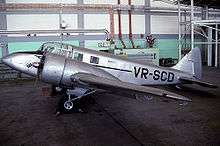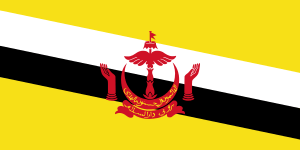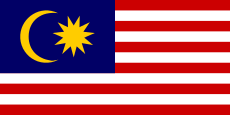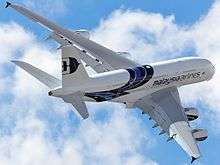Malaysia–Singapore Airlines
 | |||||||
| |||||||
| Founded | 1966 | ||||||
|---|---|---|---|---|---|---|---|
| Ceased operations | 30 September 1972; split into Malaysian Airline System and Singapore Airlines | ||||||
| Hubs |
Singapore International Airport Sultan Abdul Aziz Shah Airport | ||||||
| Fleet size | 13+ | ||||||
| Headquarters | Raffles Place, Singapore | ||||||
| Key people | Tun Ismail Ali (last Chairman of MSA) | ||||||
Malaysia–Singapore Airlines (MSA) came into being in 1966 as a result of a joint ownership of the airline by the governments of Malaysia and Singapore.[1] The airline ceased operations after 6 years in 1972 when both governments decided to set up their own national airlines. Hence from that year onwards, Malaysian Airline System, now called Malaysia Airlines, and Singapore Airlines were formed.
History
The airline traced its roots to the formation of Malayan Airways Limited in 1946. Starting its first flight on 1 May 1947, the Singapore-based carrier flew on domestic routes between Kuala Lumpur, Ipoh, Penang and Singapore on an Airspeed Consul twin engined aeroplane. In April 1948, the airline flew direct international routes from Singapore to Saigon in Vietnam, Batavia (now Jakarta), Medan and Palembang in Indonesia, and to Bangkok in Thailand via Penang. It also flew a route connecting Penang with Medan.
The airline grew rapidly in the next few years, boosted by rising demand for air travel during the post-war period, where flying was no longer a privilege for the very rich. By 12 April 1960, the airline was operating Douglas DC-3s, Super Constellations and Viscounts on new routes from Singapore to Hong Kong, and from Kuala Lumpur to Bangkok via Penang. Flights were also introduced from Singapore to cities in the Borneo Territories including Brunei, Jesselton (now Kota Kinabalu), Kuching, Sandakan and Sibu.

In 1965, Borneo Airways was amalgamated with Malaysian Airways, and led the formation of Malaysia–Singapore Airlines.
The last of 30 737-100s built was delivered to Malaysia–Singapore Airlines in October 1969.[2] This resulted in the return of the last MSA De Havilland Comet 4s leased from BOAC being returned to that airline.
Name changes
The airline saw its name changed twice due to political shifts. In 1963, the creation of the Federation of Malaysia prompted a change of name to "Malaysian Airways". Singapore's expulsion from the federation in 1965 led to another name change in 1966 to Malaysia–Singapore Airlines (MSA) when the two separate governments took joint ownership of the airline.
MSA Building
MSA had its downtown offices at Robinson Road in Singapore's business district. The building later became SIA building.
Breakup

The different needs of the two shareholders, however, led to the break-up of the airline just six years later. The Singapore government preferred to develop the airline's international routes, while the Malaysian government preferred to develop the domestic network first before going regional and eventually, long-haul. MSA ceased operations in 1972, with its assets split between two new airlines; Malaysian Airline System Berhad (now Malaysia Airlines),[3] and Singapore Airlines.
With Singapore Airlines determined to develop its international routes, it took the entire fleet of seven Boeing 707s and five Boeing 737s which would allow it to continue servicing the regional and long-haul international routes. Since most of MSA's international routes were flown out of Singapore, the vast majority of international routes were in the hands of Singapore Airlines. In addition, MSA's headquarters, which was located in Singapore, became the headquarters of Singapore Airlines.
Malaysian Airline System, on the other hand, took all domestic routes within Malaysia and international routes out of the country, as well as the remaining fleet of Fokker F27s and Britten-Norman Islanders . It began flights on 1 October 1972.
The initials MSA were well regarded as an airline icon and both carriers tried to emulate them. Malaysian went for MAS by just transposing the last two letters and choosing the name Malaysian Airline System, whereas Singapore originally proposed the name Mercury Singapore Airlines to keep the MSA initials, but changed its mind and went for SIA instead.[4] Acronyms for airline names later reduced in fashion and both carriers then moved on to their descriptive names.
Corporate affairs
In the 1960s Malaysian Airways was headquartered in Raffles Place, Singapore.[5] By 1971 the headquarters had moved to the MSA Building on Robinson Road in Singapore.[6]
Fleet

Over the years, MSA operated many aircraft including:[3][7]
|
Past destinations
Malayan Airways
-
 Brunei - Bandar Seri Begawan
Brunei - Bandar Seri Begawan -
.svg.png) Hong Kong - Hong Kong
Hong Kong - Hong Kong -
 Indonesia - Batavia / Djakarta, Medan, Palembang
Indonesia - Batavia / Djakarta, Medan, Palembang -
 Malaya - Alor Setar, Ipoh, Kota Bharu, Kuala Lumpur, Kuala Terengganu, Kuantan, Malacca, Penang, Singapore, Taiping
Malaya - Alor Setar, Ipoh, Kota Bharu, Kuala Lumpur, Kuala Terengganu, Kuantan, Malacca, Penang, Singapore, Taiping -
.svg.png) Myanmar - Mergui, Rangoon
Myanmar - Mergui, Rangoon -
 Philippines - Manila
Philippines - Manila -
.svg.png) Sabah- Jesselton, Labuan, Lahad Datu, Sandakan, Tawau
Sabah- Jesselton, Labuan, Lahad Datu, Sandakan, Tawau -
.svg.png) Sarawak - Kuching, Sibu, Miri
Sarawak - Kuching, Sibu, Miri -
 Thailand - Bangkok
Thailand - Bangkok -
 Vietnam - Saigon
Vietnam - Saigon
Malaysia–Singapore Airlines
-
 Australia - Melbourne Airport, Sydney Airport, Perth Airport
Australia - Melbourne Airport, Sydney Airport, Perth Airport -
.svg.png) Bahrain - Bahrain International Airport
Bahrain - Bahrain International Airport -
 Greece - Ellinikon International Airport
Greece - Ellinikon International Airport -
.svg.png) Hong Kong - Kai Tak International Airport
Hong Kong - Kai Tak International Airport -
 India - Santa Cruz International Airport
India - Santa Cruz International Airport -
 Indonesia - Ngurah Rai Airport, Kemayoran Airport, Polonia Airport
Indonesia - Ngurah Rai Airport, Kemayoran Airport, Polonia Airport -
 Italy - Leonardo da Vinci Airport
Italy - Leonardo da Vinci Airport -
 Japan - Itami International Airport, Tokyo International Airport
Japan - Itami International Airport, Tokyo International Airport -
 Malaysia - Kota Kinabalu International Airport, Kuala Lumpur International Airport Main Domestic Hub, Kuching International Airport, Bayan Lepas International Airport
Malaysia - Kota Kinabalu International Airport, Kuala Lumpur International Airport Main Domestic Hub, Kuching International Airport, Bayan Lepas International Airport -
 Philippines - Manila International Airport
Philippines - Manila International Airport -
 Singapore - Paya Lebar International Airport Main International Hub
Singapore - Paya Lebar International Airport Main International Hub -
 Sri Lanka - Bandaranaike International Airport
Sri Lanka - Bandaranaike International Airport -
 Switzerland - Zürich Airport
Switzerland - Zürich Airport -
 Taiwan - Taipei Songshan Airport
Taiwan - Taipei Songshan Airport -
 Thailand - Bangkok International Airport
Thailand - Bangkok International Airport -
 United Kingdom - London Heathrow Airport
United Kingdom - London Heathrow Airport -
 South Vietnam - Tan Son Nhat International Airport
South Vietnam - Tan Son Nhat International Airport -
 West Germany - Frankfurt Airport
West Germany - Frankfurt Airport
Accidents and incidents
- 23 November 1971: Fokker F27 (9V-BCU):[8] Kota Kinabalu
- 5 December 1969: Britten-Norman Islander (9M-APE)
- 17 May 1967: Twin Pioneer (9M-ANC)
- 5 March 1967: Twin Pioneer (9M-ANO)
- 30 January 1967: Douglas DC-3 (9M-AMU)
See also
References
- ↑ "Singapore Airlines". Retrieved 5 April 2007.
- ↑ "The Boeing 737-100/200". Retrieved 5 April 2007.
- 1 2 "Past, Present & Moving Forward". Retrieved 5 April 2007.
- ↑ 'Singapore doesn't need the archaic image of Mercury', Straits Times, 10 February 1972
- ↑ Flight International. 2 April 1964. 519 (Archive). "Head Office: Airways House, Raffles Place, Singapore."
- ↑ Flight International. 6 May 1971. p. 636 (Archive). "Head office: PO Box 397, MSA Building, Robinson Road, Singapore 1."
- ↑ "Malaysian Airlines System Berhad". Retrieved 5 April 2007.
- ↑ "aviation-safety.net". Retrieved 16 April 2007.
Further reading
- "MSA: the name may stay." Flight International. 22 July 1971. p. 115 (Archive)-116 (Archive).
External links
| Wikimedia Commons has media related to Malaysia-Singapore Airlines. |
